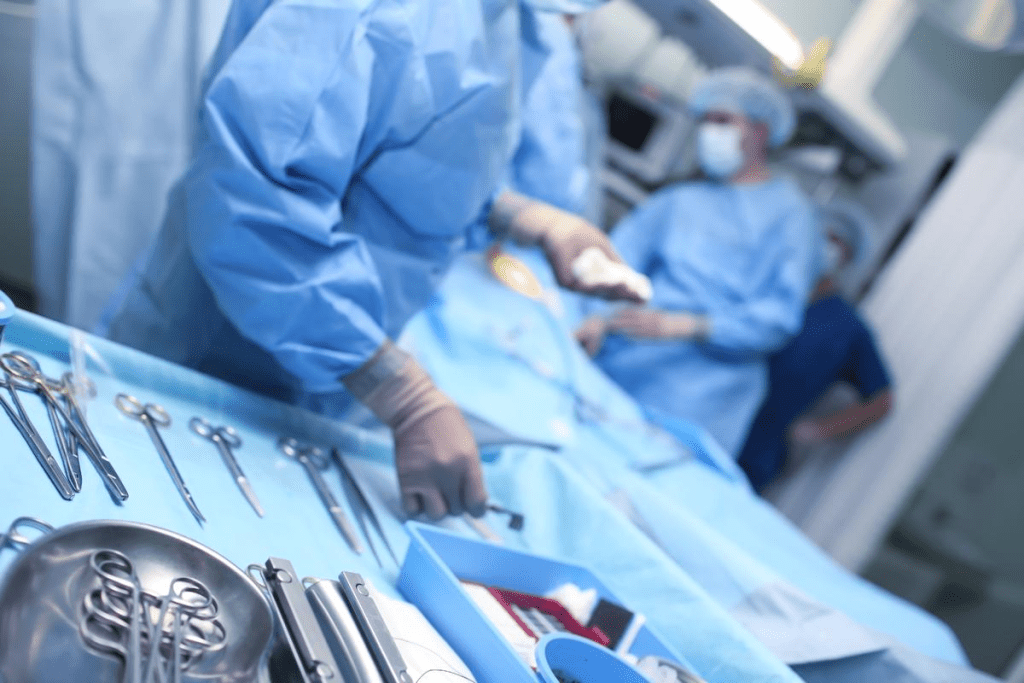Last Updated on November 14, 2025 by

Trauma surgery is a field that focuses on urgent care for severe injuries. The most common trauma surgery done worldwide is abdominal exploration, or laparotomy.
This surgery is key for treating injuries from accidents, violence, and falls. Quick surgical trauma care is vital to save lives and avoid more problems.
Medical experts know how critical fast and effective treatment is in emergencies. Abdominal exploration is a big part of this.

Trauma surgery is a vital medical field that handles life-threatening injuries. As trauma surgeons, we lead in emergency surgeries. We tackle severe injuries from accidents and violence.
This field is both complex and demanding. It needs a deep grasp of surgical methods and quick decision-making in tense situations. Data shows trauma causes about 4.4 million deaths yearly, showing how critical our work is.
Emergency surgeries are key in trauma care. We, as trauma surgeons, deal with many critical cases. This includes urgent surgeries like laparotomy for abdominal injuries and thoracotomy for chest injuries. Our role goes beyond surgery. We also provide critical care before, during, and after surgeries.
Every year, about 4.4 million people die from trauma. This number shows how vital our work is. As traumatologists, we aim to better patient care with new techniques and teamwork.
It’s key to understand trauma surgery’s global impact. By recognizing its importance, we can lower trauma deaths and enhance care worldwide.
Laparotomy, or abdominal exploration, is the most common surgery for trauma. It’s a key way to save lives and prevent more problems. About 31% of emergency surgeries are for abdominal injuries.
Laparotomy is key in trauma care because it quickly fixes serious injuries. Trauma surgery includes many procedures, but laparotomy is the most impactful.
Laparotomy is first in emergency trauma because it quickly fixes severe injuries. It lets surgeons check and fix vital organs and blood vessels. It’s chosen when there’s a big chance of abdominal trauma.
Laparotomy is a vital tool against trauma injuries. It quickly finds and fixes abdominal damage. This is key to stopping more problems and saving lives.
Laparotomy is a big deal in trauma care, making up 31% of emergency surgeries. This shows how common and serious abdominal injuries are in trauma. It shows we need skilled surgeons to handle these complex cases.
As we get better in trauma surgery, we must see the role in saving lives. Understanding its importance helps us see the complexity of trauma care. It also shows we need to keep improving and getting better at it.

Trauma surgeons are the heroes of emergency medicine. They make quick decisions that can save lives. Their job is both tough and rewarding, needing skill, knowledge, and calm under pressure.
To be a trauma surgeon, one must go through tough education and training. They usually complete a surgical residency and get certified by a surgical board. Many also do extra training in trauma surgery or critical care. This training helps them handle complex cases.
The path to becoming a trauma surgeon is long and hard. It includes:
In trauma care, decisions must be made fast and right. Surgeons work under huge pressure, quickly figuring out the best treatment. They need to know a lot about surgery and stay calm.
Good decision-making in trauma care means:
Trauma care is a team effort. It involves surgeons, nurses, anesthesiologists, and more. Good communication and teamwork are key to giving patients the best care.
A team approach is vital in trauma care, including:
Damage control laparotomy is a key surgery for severe abdominal injuries. It quickly fixes life-threatening wounds, keeps the patient stable, and stops more harm. As trauma surgeons, we know how vital this surgery is for saving lives.
The surgery follows a three-phase approach. First, we stop bleeding and prevent infection. This is done through a quick laparotomy, where we find and fix bleeding and damaged organs.
Next, patients go to the ICU for care. We watch their health, manage pain, and fix any blood issues or metabolic problems. Our aim is to get them ready for the next step.
The final phase is a planned second surgery to fully fix injuries and close the belly. This step is key to a full recovery and to quickly handle any issues.
Choosing the right patients for this surgery is key. We look at injury severity, shock, and need for immediate surgery. Those with severe injuries, shock, or needing lots of blood are often chosen.
The results of this surgery vary based on injury severity and patient health. Yet, studies show it can greatly increase survival chances for the most critically injured. We’ve seen it lower death and illness rates by acting quickly.
In summary, damage control laparotomy is a vital part of trauma surgery. It offers a structured way to handle complex abdominal injuries. By understanding its phases, who to choose, and outcomes, we can keep improving care for patients.
Managing abdominal hemorrhage in emergencies is key in trauma care. It needs skill, experience, and the latest technology. This is because abdominal hemorrhage can come from many injuries. It’s vital to stop it to save lives.
Stopping massive bleeding is the first step in managing abdominal hemorrhage. Damage control surgery is often used. It aims to stop the bleeding and keep the patient stable.
Techniques include packing the abdominal cavity and temporary closure of the abdomen. This allows for more treatment and surgery later.
Surgeons also use hemostatic agents and angioembolization to control bleeding. These methods are key in the early stages. They give time for more treatment and care.
New technology in controlling hemorrhage has greatly helped patients. Hemostatic dressings and tourniquets for the abdomen are now better. They help control bleeding more effectively.
Endovascular techniques like embolization and resuscitative endovascular balloon occlusion of the aorta (REBOA) are also important. They help trauma surgeons handle complex cases better. This reduces risks and improves survival chances.
Administering blood products is key in managing abdominal hemorrhage. Massive transfusion protocols are used for severe cases. They involve quick delivery of blood products in the right ratio.
This helps fight the effects of massive blood loss and supports the body’s clotting system. A multidisciplinary approach is vital. It involves trauma surgeons, anesthesiologists, and blood bank specialists. This teamwork ensures the best care for patients, helping them recover better.
There are many surgical procedures important in trauma care, aside from laparotomy. Trauma surgeons need to know how to do different surgeries to treat various injuries well.
A thoracotomy is a surgery that opens the chest. It’s done for serious chest injuries like gunshots or bad car crashes. Surgeons can fix or remove damaged parts this way.
Indications for thoracotomy include heart stops from trauma, big chest bleeding, and major blood vessel injuries. This surgery is urgent and needed right away.
Orthopedic trauma care is key for fixing broken bones and soft tissue injuries from trauma. These surgeries can be simple or very complex.
Doctors use external fixation, intramedullary nailing, and open reduction and internal fixation (ORIF) to fix bones. The method chosen depends on the injury’s type and how bad it is.
Traumatic brain injuries (TBI) need quick neurosurgery to avoid more damage and help healing. This can include taking out parts of the skull to ease brain pressure, removing blood clots, or fixing skull fractures.
The aim of these surgeries is to prevent more brain damage, lower brain pressure, and help the brain work better.
Vascular repair is vital in trauma surgery to get blood flowing again to injured areas. Doctors use direct repair, bypass grafting, and endovascular methods.
Choosing the right repair method depends on the injury’s location and how severe it is. Surgeons must carefully decide based on these factors.
The numbers on trauma surgery in the US are scary, with a big jump in death rates from 2000 to 2020. We look at the trends and stats that are changing trauma surgery in the US.
Data from trauma centers in the US shows a 91% increase in trauma mortality from 2000 to 2020. This big jump shows that traumatic injuries are getting worse and more complex. We need to figure out why this is happening, like changes in injuries and how well trauma care is working.
The US is seeing more injuries from firearms, falls, and stabbing. These injuries are tough for trauma surgeons and put a lot of pressure on the healthcare system. We need better ways to prevent these injuries and improve how we treat them.
Trauma centers are not spread out evenly in the US, causing access challenges in some areas. Rural places have a hard time getting to trauma care fast. We must fix these issues to make sure everyone gets the trauma care they need.
Looking at these trends, it’s clear we need to tackle the rising death rates and make trauma care more accessible. By understanding these numbers and trends, we can improve trauma surgery results and save more lives.
Improving trauma care is key to saving lives and bettering patient results. Trauma surgeons are essential, bringing their special knowledge and skills to urgent cases.
It’s vital to keep improving in trauma surgery and care. By using new ideas and the skills of trauma surgeons, we can make care better and lower death rates from injuries.
The field of trauma surgery will keep growing, thanks to new medical tech and methods. Our dedication to top-notch healthcare will stay strong. This ensures patients get the best care when they need it most.
Trauma surgeons are key in emergencies. They use their special training to make quick decisions. They work with teams to treat serious injuries.
Laparotomy is a surgery that opens the abdomen to check and fix injuries. It’s the most common because it’s needed for many types of abdominal injuries.
Damage control laparotomy is a special surgery for severe abdominal injuries. It’s used when patients need quick help to stop bleeding and prevent infection.
To stop massive bleeding, surgeons use packing, ligation, and hemostatic agents. New technology, like hemorrhage control devices, also helps.
Other common surgeries include thoracotomy for chest injuries and orthopedic fixes for fractures. There are also neurosurgical and vascular repair procedures.
Trauma causes about 4.4 million deaths each year worldwide. This shows how big of a problem it is globally.
Having enough trauma centers and good access is key for quick and effective care. Without it, treatment is delayed, and outcomes suffer.
Trauma surgeons go through a lot of education and training. This includes medical school, general surgery residency, and sometimes extra fellowship training.
Trauma surgery has changed a lot. It now uses new technology and techniques, like damage control laparotomy, to improve patient care.
Trauma care faces challenges like rising death rates and access issues. To solve these, we need to keep innovating and improving how we deliver care.
Subscribe to our e-newsletter to stay informed about the latest innovations in the world of health and exclusive offers!